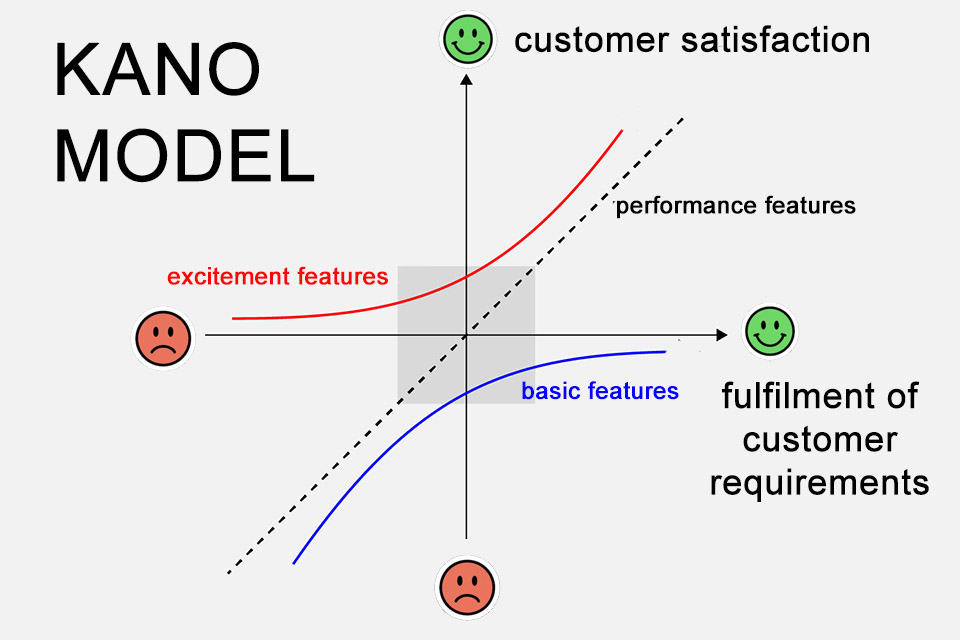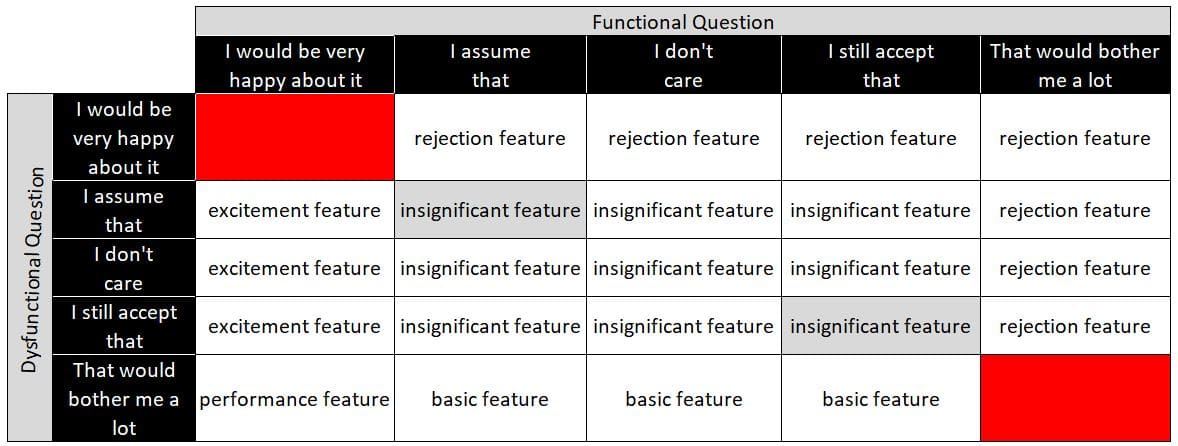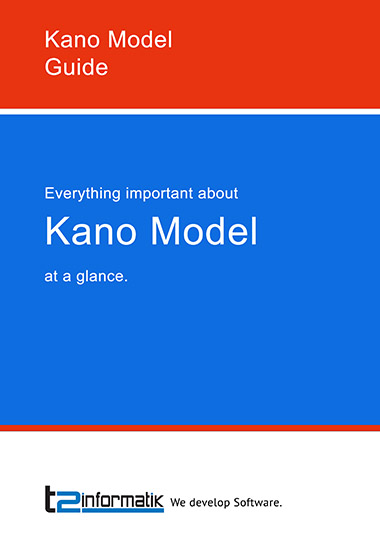What is the Kano Model?
Table of Contents: Definition – Visualisation – Features and examples – Bipolar questioning – Questions from the field – Download – Notes
Smartpedia: The Kano Model describes the relationship between customer satisfaction and the fulfillment of customer requirements by defining product characteristics to which users react differently.
Kano Model definition
The Kano Model describes the relationship between customer satisfaction and the fulfilment of customer requirements. It is therefore also referred to as the customer satisfaction model.
The model is named after Noriaki Kano, a former professor at Tokyo University of Science. As early as 1978, he recognised that customer requirements can have five different characteristics that have different effects on customer satisfaction:
- basic features,
- performance features,
- excitement features,
- insignificant features and
- rejection features.
Each feature can relate to both products and services and each feature can influence individual customer satisfaction.
Visualisation of the Kano Model
The visual representation of the model does not show any specific measuring points, so that only qualitative, but no quantitative statements can be made. It is therefore not possible to see which performance feature is more important in comparison to another performance feature.
In the middle of the figure is the so-called indifference zone. Here, the satisfaction values behave moderately. Outside the indifference zone, the satisfaction values of the basic and inspiring features increase or decrease ‘disproportionately’, while the performance features develop ‘linearly’.
Over time, characteristics often shift. For example, basic features can become enthusiasm features (example: ‘wipe’ on smartphones) and basic features can become performance features (example: no extra costs for seats, luggage or food on board when travelling by air).
Features and examples of customer satisfaction in detail
Noriaki Kano defines five criteria in his model that have an influence on customer satisfaction:
- Basic Features
Basic features – also called threshold attributes, must-be expectations, expected or basic needs – are self-evident for customers and are assumed. They are regarded as expected requirements.
Missing basic characteristics cause dissatisfied customers, but existing basic characteristics do not cause satisfaction.
Even with a very good quality of individual basic factors, customer satisfaction cannot be increased.
Example: A motorcycle has two wheels. If it had less than two wheels, potential motorcyclists would certainly be very dissatisfied. If the wheels had a special tyre profile, most motorcyclists probably wouldn’t care.
More examples: Colour TV, automatic channel search in TV set, saving of TV channels in a desired order, connections for game consoles on TV, individually adjustable ring tones in mobile phones, hands-free system, height-adjustable steering wheel and heated seats in cars.
- Performance Features
Performance features – also called quality characteristics or normal requirements, satisfiers, linear or one-dimensional attributes or performance needs – are explicitly expected by customers. They have a direct influence on satisfaction. Customers often compare different products based on performance characteristics.
If performance features are missing, dissatisfaction arises; if they are exceeded, satisfaction increases accordingly.
Especially in markets with a lot of competition they are important for market success. Performance features can be determined through interviews and/or market observation.
Example: Online marketing tools offer the possibility to store your own keyword sets in order to keep an eye on the Goolge ranking of the corresponding terms. If you cannot store your own sets or if the number of keywords is limited, this leads to dissatisfaction, but if you can monitor an infinite number of keywords, this increases satisfaction.
More examples: Resolution of the monitor, fuel consumption of the car, free delivery service of a supermarket, shelf life of the milk, seat heating on the back seat in the car, automatically retractable convertible top, level of insurance cover, return transport in the event of illness / accident abroad, free battery replacement service for watches in all branches worldwide.
- Excitement Features
Excitement features – also called dilighters or exciters, attractive attributes, exciting needs or enthusiasm factors – inspire customers. They are not expected by customers and the lack of corresponding characteristics does not generate dissatisfaction.
If an excitement feature exists, it leads to a disproportionate benefit and advantage.
Attractive features turn customers into voluntary brand ambassadors. Since many products often pursue a “me-too strategy” and cannot stand out from the competition, companies sometimes try to generate enthusiasm with additional attention.
Examples: A glass of sparkling wine at the hairdressers, an additional toy digger with the car purchase, cashless payment by mobile phone at a kiosk in the middle of nowhere, package delivery directly to the boot of your car, making phone calls with your wristwatch, and automatically preheated car.
Note: In numerous publications, the following two characteristics are not mentioned, but they round off the consideration of the factors influencing customer satisfaction.
- Insignificant Features
Insignificant features – also called indifferent qualities – lead neither to satisfaction nor to dissatisfaction. Or in other words:
The existence or non-existence of the characteristics has no influence on customer satisfaction.
They are irrelevant in the truest sense of the term.
Example: Playing radio stations on the TV set. Very few people use their TV set to listen to music. Ergo: very few people are interested in the existence of the corresponding possibility. The feature is irrelevant.
More examples: Position display of the fuel tank cap in the speedometer, illumination of the make-up mirror for car passengers.
- Rejection Features
Rejection features – also called reverse qualities or dissatisfiers – lead through mere existence to dissatisfaction.
If rejection features are present, this leads to dissatisfaction, but if none are present, this does not generate satisfaction.
Manufacturers or service providers should therefore make sure that there are no factors that lead to customers being dissatisfied and refraining from using the product or service.
Example: Online forms with a lot of mandatory information that has nothing to do with the actual subject of the request/entry.
More examples: Environmental zones in city centres, queues at supermarket cash registers, rust on rust-free screws, parcel deliveries that are not delivered to the recipient but somewhere in the neighbourhood.
Would you have chosen other examples? Do you rate characteristics differently? This is understandable, because the classification of characteristics is always subjective. In the case of services, too, there are many characteristics with regard to punctuality, reliability, diligence, friendliness, cleanliness, response time, goodwill, accessibility, etc. that can inspire customers or are irrelevant to them.
How does bipolar questioning work in the Kano Model?
How can companies classify product characteristics as basic, performance or excitement features?
A bipolar survey with positive and negative questions, which Noriaki Kano has come up with, can help here:
- Functional – i.e. formulated positively – question: What would you say if the product had “xyz”?
- Dysfunctional – i.e. formulated negatively – question: What would you say if the product DID NOT have “xyz”?
Noriaki Kano defined as possible answers to both questions:
- “I would be very happy about that”,
- “I assume that”,
- “I don’t care”,
- “I still accept that” and
- “That would bother me a lot”.
The combination of the answers to the functional and dysfunctional questions results in the classification of the characteristics:
The two red fields show contradictory statements.
The two grey fields show alternative interpretations (an insignificant attribute or an answer to be questioned or ignored).
Questions from the field
Here you will find some questions and answers from the field:
What is the origin of the Kano Model?
The Kano Model goes back to Frederick Herzberg’s Two Factor Theory – also known as Motivation-Hygiene Theory – from 1959. The American professor of ergonomics defined motivators and hygiene factors and described satisfaction and dissatisfaction not as opposites, but as two independent characteristics. Herzberg had observed that satisfaction does not arise automatically just because there are no reasons for dissatisfaction.
The Kano Model is a transfer from ergonomics to the analysis of customer requirements. The basic features of the Kano Model correspond to the hygiene factors of the Two Factor Theory. Performance features and excitement features are comparable to motivators.
What insights can be gained from the Kano Model?
- Individual product characteristics are of different importance for customer satisfaction.
- If basic features are missing, then customers are dissatisfied. Products should therefore cover basic features in order not to lose the competition for customers at an early stage. At the same time, you will not be able to win customers with basic features. A pure me-too strategy is therefore usually not conducive to success.
- Performance features are very important for customers, because products and services are compared on the basis of these features. Here you could stand out from the competition with the same number of performance factors with better performance or with more performance attributes.
- Delighters lead to disproportionate customer satisfaction. They are the most important features of products. However, it is difficult to find them because they cannot be determined by interviews or market observation. On the one hand innovations are in demand here, on the other hand the timing is also an important aspect: the first tablet PCs were available as early as 1997/98, but the idea could only be successfully marketed from 2010.
- In the ideal case, performance attributes and excitement features not only ensure satisfied or even enthusiastic customers, but also – depending on the industry and business model – follow-up orders, recommendations, positive evaluations, a decreasing number of cancellations, higher payment morale, etc.
- Companies should avoid investing in insignificant features because they have no influence on customer satisfaction and do not help with product differentiation.
- The importance of product characteristics and therefore customer satisfaction changes over time. Excitement features (e.g. wiping technology on a smartphone) often become basic features. There is a habituation effect. Sometimes a basic feature becomes a performance feature (e.g. free seat selection in an aircraft, free catering on board), which then helps to differentiate.
- Rejection features should be avoided at all costs. Often they do not only lead to rejection by individual customers, but “talk around” and the image of a product and/or a manufacturer suffers.
What happens after the product characteristics have been analysed?
What happens after the analysis of the product characteristics? Which features should be implemented first? If companies ask themselves such questions, they are – at least theoretically – already on the right track. They focus on the needs of customers and stakeholders.
Of course, products and services must have characteristics that are also present in potential competitors. In the long run, it is unlikely that manufacturers and service providers will be able to do without basic features, but temporarily and with open and honest communication, users could possibly accept this. The actual competition takes place in the area of performance and enthusiasm factors.
Enthusiasm characteristics are on the one hand difficult to identify and on the other hand usually only temporary. Example: the wiping technology in smartphones; nobody knew it before it was “invented”, so that probably only a few people were able to express a corresponding idea. Today, every user can “wipe” his smartphone – the enthusiasm is gone. It is probably no longer even a performance factor, but merely a basic feature. Manufacturers and service providers naturally recognise this and therefore try to supplement products and services externally. Example: Doormats in the car. In the past, it was common for cars to be sold without floor mats. What did a salesperson do to inspire potential customers and convince them to buy? He “gave” them floor mats. These were awarded with a prize, so that the customer could get the impression that the salesman would take special care of him. Nowadays this is clear to most car buyers. They are not enthusiastic about such basic features. Car manufacturers therefore offer free warranty extensions, inspections and repairs. In the sense of the Kano Model these are probably not enthusiasm factors, but only performance factors. Or do you see it differently?
Impulse to discuss:
Is the model more a tool for marketing communication or product development?
Notes:
Here you can find a German video on the Kano Model.
Here you will find an application of the model in time management and the consideration of how it can be used to increase personal productivity.
If you like the article or would like to discuss it, please feel free to share it in your network. And if you have any comments, please do not hesitate to send us a message.
And here you can find additional information from our t2informatik Blog:





